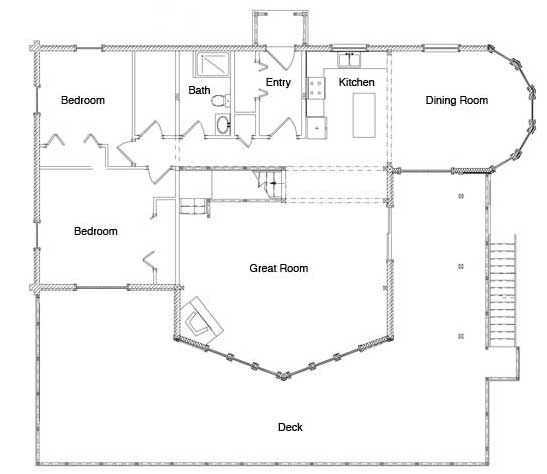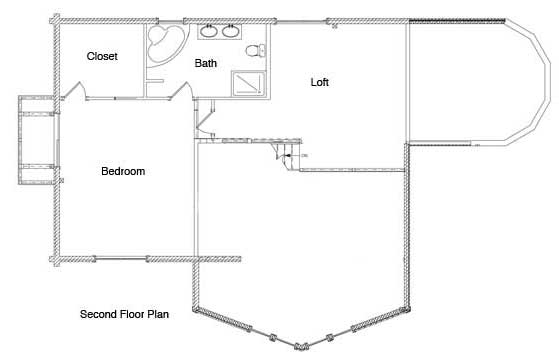Reducing Our Carbon Footprint
We want to enjoy the conveniences of a modern lifestyle while still being able to protect the environment.
By employing a range of eco-friendly systems we look forward to cost free, self-sustained living for many years.
Imagine never having to pay for heating, hot water, air-conditioning, and electricity. We will be making our own clean, free energy, no burning of fossil fuels and no creation of greenhouse gases.
House Design Planning
Customizing a specific log-home design to suit our needs has saved us a lot of time and effort. We were able to visualize our home by creating 3D renditions that brought our dream to life.- Copyright 2015 © GreenLogHome. All rights reserved. • Privacy Policy • Terms Of Use •
Geothermal Systems
If we break the word geothermal down, it literally means 'Earth' and 'heat'. The earth's heat flows from its core to the surface. As the heat nears the surface we can harness its energy. There are many benefits when implementing geothermal power. The most obvious, being is that it is a clean, sustainable, renewable source of power. It is not only reliable, it is continuous, infinite, and free.
The most important benefit of geothermal energy is that it does not require any burning of fossil fuels, therefore it helps to slow down the effects of global warming.
Recent studies indicate that if only 40% of the heat under the United States was tapped, it would meet current energy demands fifty-six thousand times over.
By drilling a couple of holes approximately 250 ft deep, we will be able to harness the heat energy from the ground by using the WaterFurnace 'Envision' system. This is achieved through an all-in-one unit that utilizes an ozone-free refrigerant to convert the geothermal heat into on-demand heat, hot water and air-conditioning. Our system will be a closed loop design. Look on their website to find which type of system will work best in your applications.
www.WaterFurnace.com
- Copyright 2015 © GreenLogHome. All rights reserved. • Privacy Policy • Terms Of Use •
Solar Power
Choosing solar power as an alternative energy source is a great way of tapping into a source of green, abundant energy. Today Photo-Voltaic(PV) panels blend into the structure of the home, making them a viable non-obtrusive technology. PV cells convert sunlight into DC (direct current) electricity. Most PV cells are covered in semi-conductor material such as silicon. Other types of materials used are a polycrystalline cell or the highly effective gallium arsenide, which is a more expensive alternative. The effectiveness of the DC current produced depends largely on the intensity of the solar radiation and the materials used. The whole surface of the PV cell generates current, additional electrical connections are used to harness the DC current generated.
New thin-film technologies are emerging; these require few materials and can be easily sized to fit around varying building components. These also use a silicon semi-conductor, but other newer varieties include copper indium diselenide and cadmium telluride.
PV cells are now also being incorporated into PV modules. As the name suggests the panel incorporates grouped cells and electrical connections into a self-contained parcel.PV modules come in two varieties: 'flat-plate' or 'concentrator' systems. Flat-plate PV modules use direct and indirect sunlight and can be easily orientated to maximize the sunlight. Concentrator PV modules require direct sunlight. However many less 'concentrator' PV modules are required to generate a current than 'flat-plate' ones. For more over-cast regions the 'flat-plate' PV module would be preferred.
Modules are generally frame mounted and connected to a sealed junction box. Some PV module manufacturers are incorporating all the elements required to connect the junction box through clever connectors that join on assembly of the modules.
So how many PV cells/panels do you require? There are several variables, such as: your average energy consumption, your building, the geographical location and selection of PV technology used.
Let us assume that your monthly electricity consumption is an average of 920 kWh and that you get 'good' solar coverage for your region. The required solar system capacity will be 10.00 kW of peak power (DC watts) and a roof area of approximately 1,000sqft.
The peak power is the amount of power output a PV module produces when operating at a temperature of 25 degrees Celsius in full sunshine of 1,000 watts per square meter. The set-up process is complicated and always based on the end users power consumption. A good resource that gives you an approximate gauge for solar estimation is the 'Finding Solar' website 'solar estimator'.
- Copyright 2015 © GreenLogHome. All rights reserved. • Privacy Policy • Terms Of Use •


- Copyright 2015 © GreenLogHome. All rights reserved. • Privacy Policy • Terms Of Use •
Good Insulation
When we learn how heat moves around the home, it gives us a better understanding of why we need to use good insulation. When heating the home, warm air will gravitate to cooler temperatures outside. In the summer the opposite occurs, warmer air will try to move into the home, where the air is cooler. Good insulation works like a barrier because it prevents the movement of warm air to the exterior in winter and prevents warm air from entering the home during the summer. Any materials used to build your home can either transfer heat or absorb it. Any materials include: membranes, roofing, windows and in our case logs (as opposed to bricks or stick and framing)! The better the material, the more it stops or slows down heat loss and the more effective it is as an insulator.
The better insulator a material is, the higher the r-factor (multiply r-factor times the thickness of your material and you get the r-value). The higher the r-value the less heat you will loose and the less energy you will consume while trying to heat or cool the home.
We chose our logs, windows, roofing and membranes as (in our opinion) they all have a better thermal mass effect and are better insulators compared to many other products available.
Solid White Cedar Logs:
We decided to use MCLH for several reasons, from an insulation point of view, White Cedar logs possess a greater thermal mass than pine. This in a nutshell means that once built, the cedar log home will have a much greater resistance to heat loss than pine.
www.mclh.net
Windows:
Pella Windows provide energy efficient windows that will save money by lowering heating and cooling bills. Thereby ultimately reducing energy consumption and minimizing waste and pollution derived from the burning of fossil fuels.
Pella produces a wide range of different windows. We will be using energy-saving; argon-gas filled, Low-E glass, triple-pane options with between-the-glass blinds to further increase energy savings and can even reduce outside noise - like lawn mowers and traffic - by up to 80%.
www.pella.com
Roofing:
MBCI provides Cool metal roofing. Their metal roofs are energy efficient, sustainable, recyclable, durable, lightweight and cost effective. As an Energy Star Partner, MBCI offers Cool Roof colors that have reflectivity performance levels that meet Energy Star criteria, offering considerable energy savings.
www.mbci.com
Membranes:
Once in place the thermal mass effect of the Tuff-N-Dri compound significantly reduces any heat loss. Typically 50% of the home's heat loss comes from poorly insulated basements. Great insulation prevents damp (and consequently mold) from occurring and that's important when improving air-quality too. We will be using the Horizon system. This method insulates the foundation all the way up to the first sub-floor. With an outer layer of concrete sprayed on the surface, it creates the look of a custom stone foundation, while preventing heat loss.
www.tuff-n-dri.com
- Copyright 2015 © GreenLogHome. All rights reserved. • Privacy Policy • Terms Of Use •
Stain - Sashco
We want to preserve our log home for many years to come. Choosing the right stain and sealant is essential for years of maintenance-free living. We are currently restoring the Green Log Home and Dream House Log Cabin with Sashco Transformation Stain. Our original stain and caulk, made by Sansin, failed prematurely. After having spent a lot of time researching different companies and their products, we chose 'Sashco Transformation' to restore and bring the beauty back to our cedar log home.
Sashco makes an array of color choices in their stains. We have opted for Dark Tone Brown, to us it is a natural looking wood compared to the orange color that we see on so many log homes. As part of our log home restoration we are also using 'Sashco Conceal' to fill all upward facing checks, open gaps and butt joints. Our original caulking (also made by Sansin) did not stretch as the logs shrunk; leading to a seal failure around the home resulting in heat loss. We are delighted that not only is Conceal able to take the stain color of the house to blend in; it is very elastic and will stretch for years to come as the house moves (all log homes move). As a point of reference, a one inch circle when dried will stretch to 6 inches!! Our Sansin caulk barely stretched half an inch, thus the early failure. We are excited to say that Sashco products will be used to keep the Green Log Home looking great for years to come. We are nearly complete with the restoration and will be sharing some pictures of the process.
If you are looking to refinish your log home and minimize log maintenance, look no further than Sashco products.
www.sashco.com
- Copyright 2015 © GreenLogHome. All rights reserved. • Privacy Policy • Terms Of Use •


